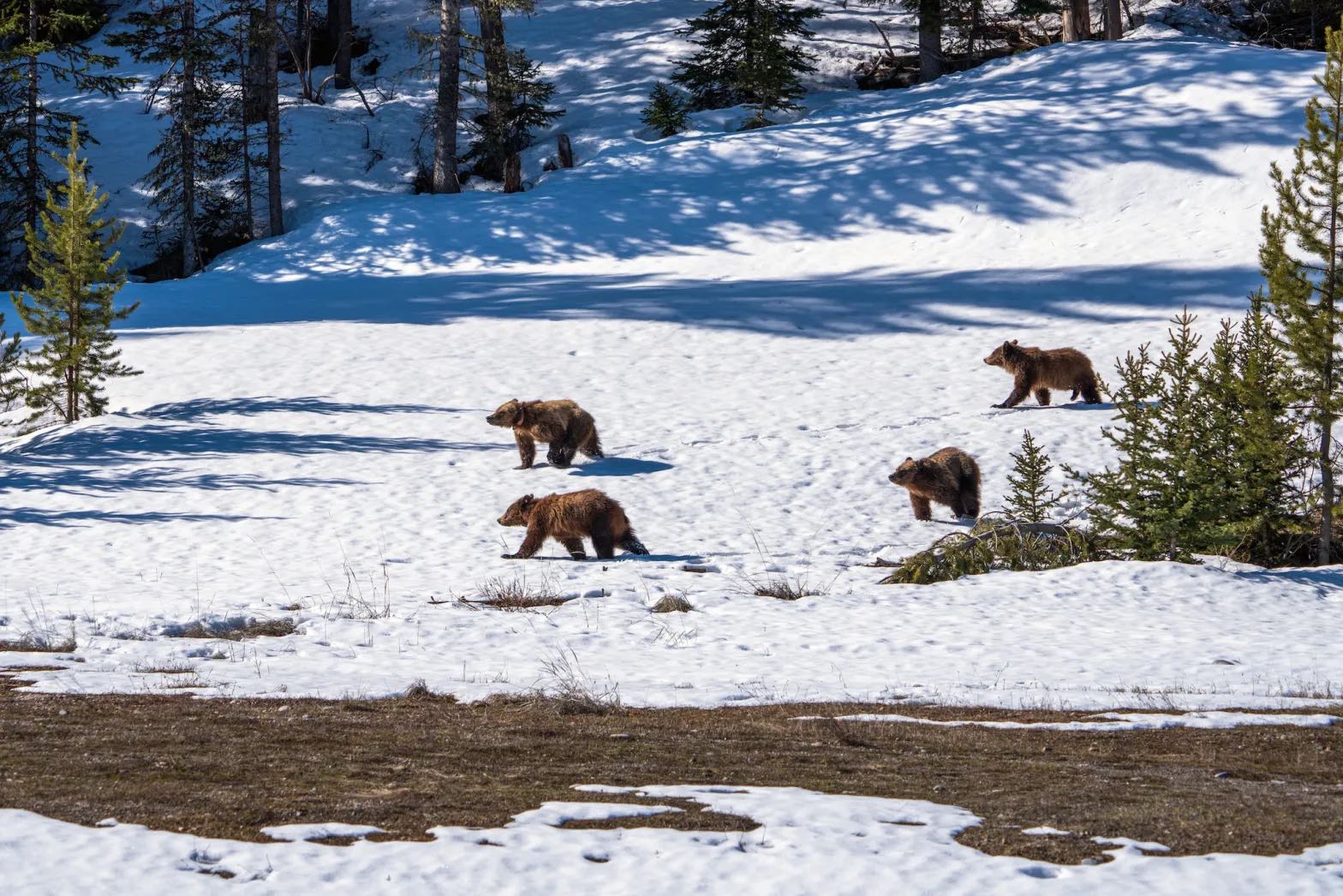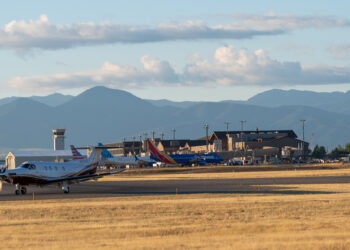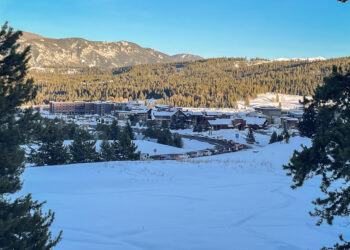Most Wyoming grizzlies are now killed, not relocated, following the types of human interactions the soon-to-be-separated subadults are conditioned for.
By Mike Koshmrl WYOFILE.COM
GRAND TETON NATIONAL PARK — Two of the beloved, embattled grizzly bear cubs took the lead, pushing down through the still-snowy flank of Signal Mountain ahead of their famous mother, grizzly bear 399.
The grizzlies — five, in all — poked through the timber at 8:42 a.m., ambling across Teton Park Road and proceeding down to the receded shoreline of Jackson Lake. They came through the trees less than 100 yards from where Tom Mangelsen expected. The 76-year-old Jackson Hole photographer has practice patterning the movements of the 26-year-old matriarch bruin of Grand Teton National Park, a bear he’s tracked since she started raising her litters roadside in 2006. He also knew where to head for the shot.
“They’ll go this way,” Mangelsen said. He flipped a U-turn in his Ford SUV, pointed toward Jackson Lake Dam, and eased to a stop where the grizzlies, framed by the Teton Range, padded down the snowy shoreline in view of a roadside pullout.
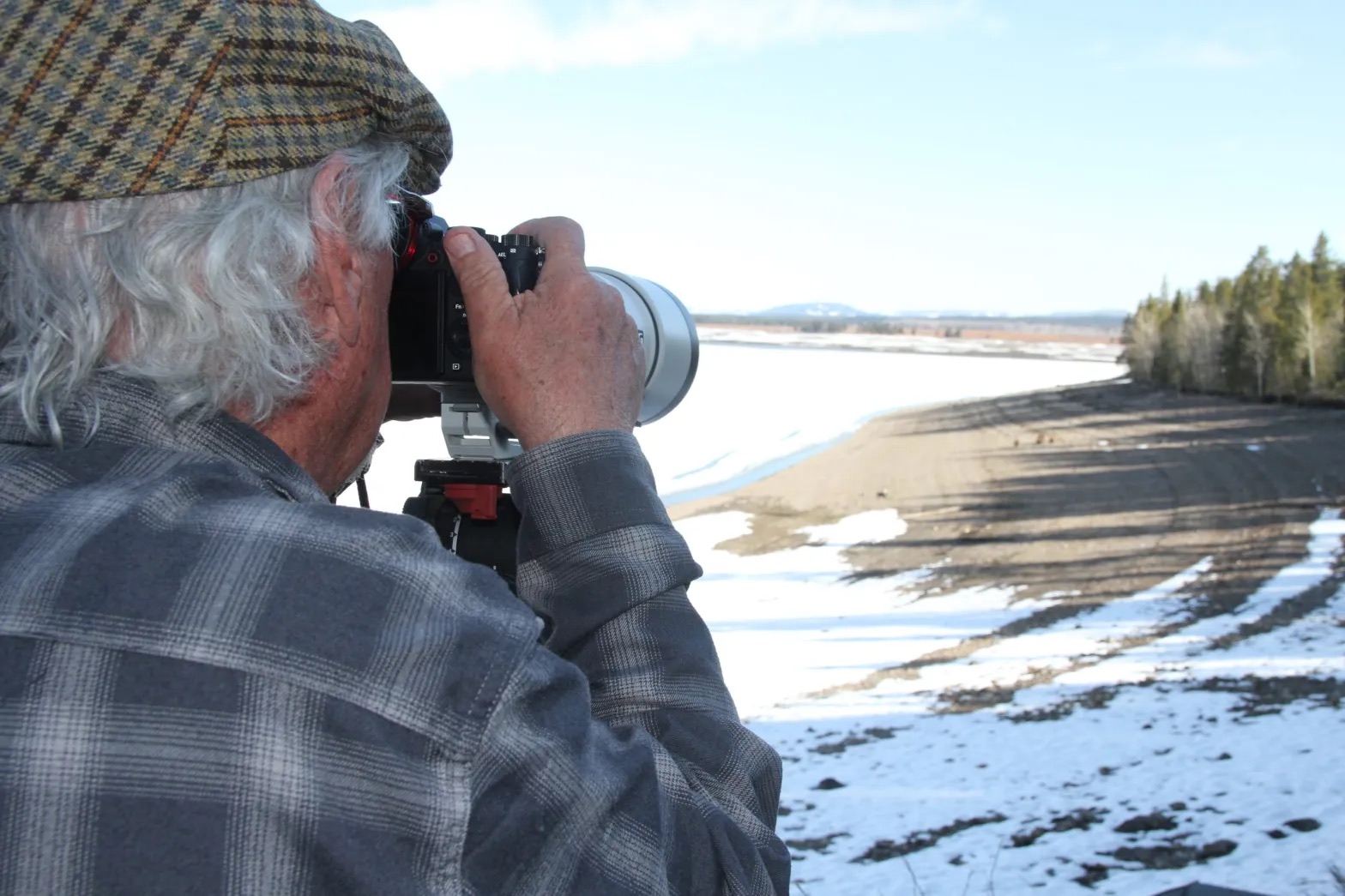
Mangelsen and a handful of fortuitous fellow photographers were silent, save for the clicking of camera shutters. But word spread quickly.
Within a few minutes, a caravan of photographer-filled vehicles that had been staged nearby rolled into view. Soon there was a frenzy: scores of photographers and tourists jostling for a close look.
Tyler Brasington, a Grand Teton bear management ranger who waited at the dam, had experience with “bear jams” here. He predicted the swelling crowd would next glimpse the grizzlies near “John’s Pond,” just above the dam.
“They’ve come through there before,” Brasington said of the bears. “That’s a very difficult area to manage a jam, just because there’s no place for people to pull off.”
Less than a minute later, the five grizzlies ascended from the lake, crossing the road exactly where the ranger predicted.
“We can all stop right here,” Brasington told frantic photographers and grizzly-watching passersby.
A few folks momentarily heeded the guidance. But most proceeded onward, following five grizzly bears. For the next hour the crowd kept growing, cameras clicking and memories amassing as the fivesome swam the Snake River and the cubs dutifully played their parts: adolescent, charismatic animals, wrestling in view of the highway.
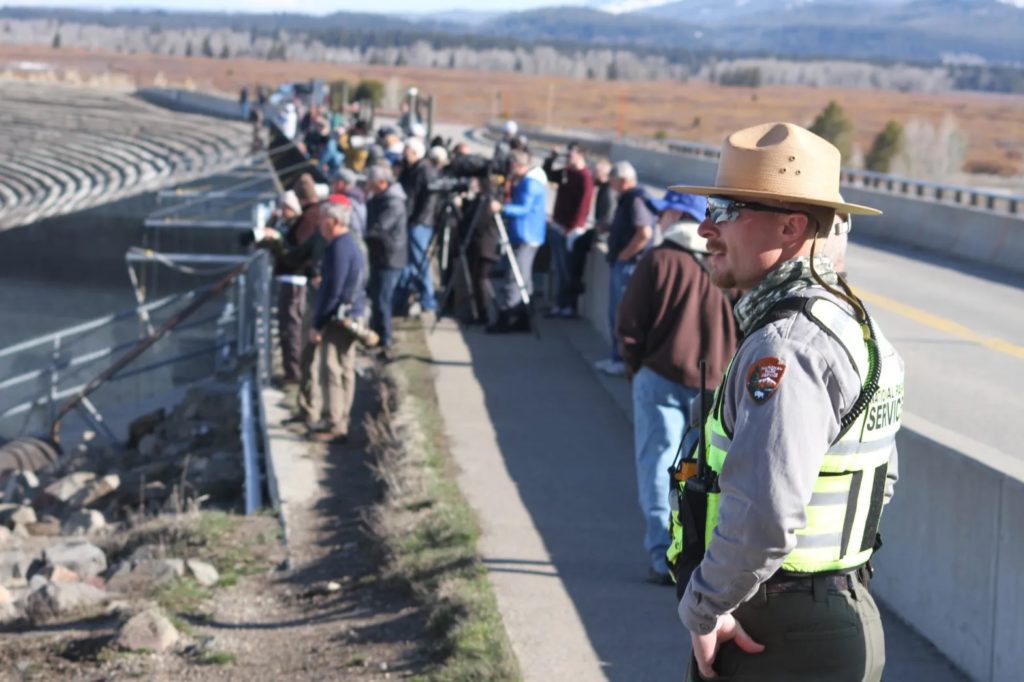
Those same youngsters, accustomed to admiring throngs and adept at putting on a show, will very soon arrive at a perilous crossroads. Turn toward the unfamiliar remote expanses of the Greater Yellowstone Ecosystem, and the up and comers might just carve out a living. But if they choose, instead, to stay on the path that runs near humanity, they’ll likely be caught and killed.
Soon to split
Wednesday’s sighting might be one of the last times bear 399 and her cubs are visible together as a family unit.
“They’ll still potentially be traveling together for another week or two,” said Dan Thompson, who oversees large carnivore management at the Wyoming Game and Fish Department. “Anytime between now and June, when breeding starts, she’ll really kick those 2-year-olds out.”
Once that happens, the independent subadult grizzlies will be on their own, facing a number of factors stacked against them.
Wildlife managers have been clear: the subadults will lose the special treatment afforded to their mother, the subject of an intensive around-the-clock surveillance and conflict-reduction operation during 2021, a year when the famous sow spent more time on private land than within the protective borders of Teton Park. Due to their upbringing in a national park that attracts 4 million-plus visitors each year, the subadult bears also lack a fear of humans. Worsening their prospects, the youngsters know to associate ranches and residential yards with food, the result of deliberate wildlife feeding and unsecured livestock feed and apiaries the famous brood of bears managed to get into.
In short, after a lifetime being conditioned to misbehave, the bears will be suddenly subject to a wildlife management regime that is more prone to kill problem grizzlies than to relocate them.
“It would be tough to relocate them successfully,” Thompson said. “The only other option is, they would likely be [killed].”
That jibes with the long-term trend. The U.S. Fish and Wildlife Service ultimately calls the shots on what becomes of federally threatened grizzly bears, but the Wyoming Game and Fish Department makes recommendations about their fates, and lays out the numbers on captures, relocations and removals in annual reports. A decade of data in those reports show that the number of grizzlies captured has been stagnant, at approximately 40 animals annually. But the agencies have generally moved away from relocating bruins that do get trapped. Between 2012 and 2016, 34 percent of trapped grizzlies were killed, according to WyoFile’s calculations made from agency data. But in the five years since, fatal outcomes were more likely: 55 percent of captured grizzlies were put down.
“We’re learning from our management actions in the past,” Thompson said. “With the potential and amount of human injuries, and worse, we’ve had the past several years, we’re just very reluctant to move a bear involved in a conflict, especially after October, but even into September.”
The reason fewer bears are being relocated during hunting season, Thompson explained, is public pressure. There’s “no data,” he said, that suggests a moved grizzly is more dangerous to people or less likely to survive in its new environment.
“It’s just not tolerated anymore by the public,” Thompson said.
Wyoming Game and Fish intends to take the lead in managing bear 399 and her offspring if and when those bears depart Teton Park this year, together or independently. That’s a departure from 2021, when the state agency pulled back its on-the-ground management during the family group’s extended stay in southern Jackson Hole. The federal government dispatched its own wildlife officials instead, running up a big bill in the process, according to Fish and Wildlife Service’s grizzly bear recovery coordinator Hilary Cooley.
“We spent $60,000 last year, the Fish and Wildlife Service in Jackson,” Cooley said. “We can’t do that, and we shouldn’t. We’ve got 2,000 bears in the Lower 48 states.
EDITOR’S NOTE: Jackson Hole News & Guide reported that as of May 12 Grizzly 399 and her cubs have started to separate.



